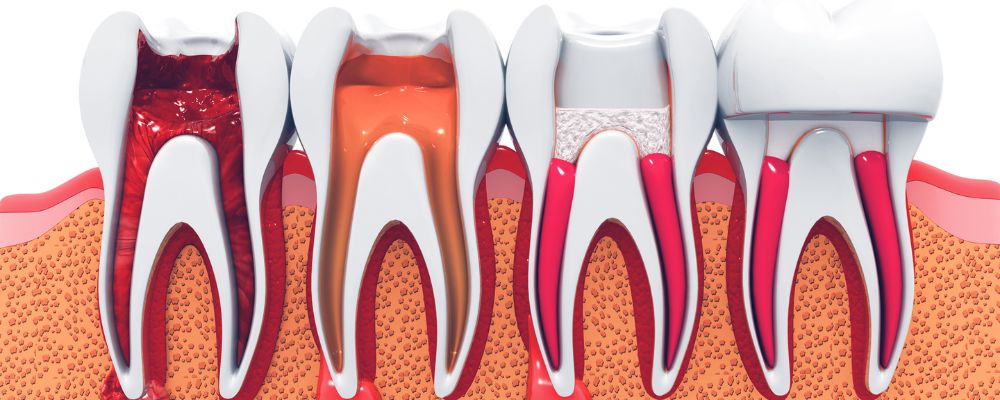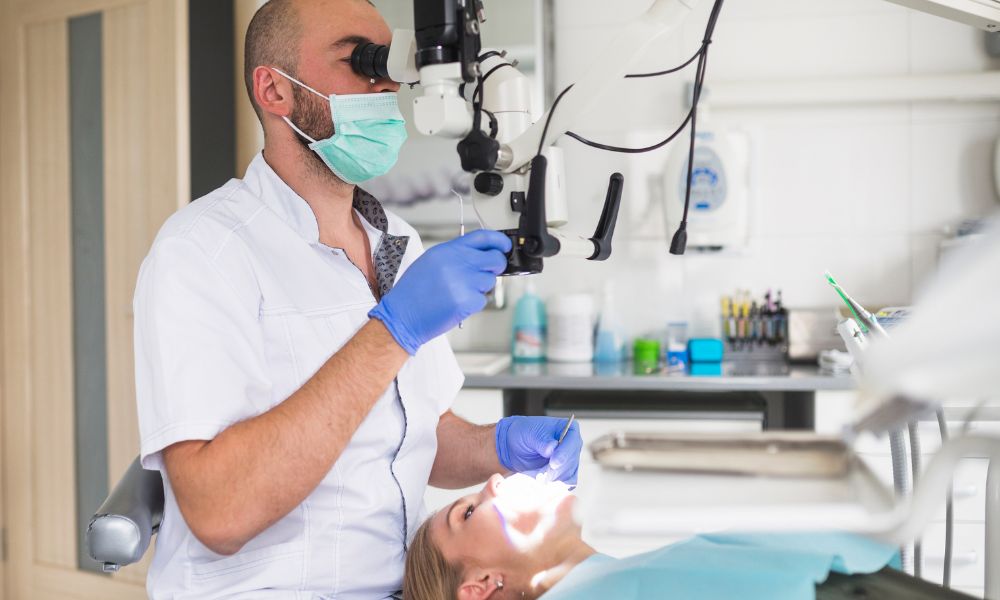Dental microscopes are the new standard of care for root canal treatments. We have two “Global” dental microscopes in our practice to facilitate root canal treatments and other procedures requiring high magnification and precision. The use of a microscope is essential because the root canals of teeth often have several central canals and are not always straight. Therefore, high magnification is required to thoroughly clean these canal spaces. Older “traditional” root canal treatments relied on the naked eye or a surgical loupe, which meant that undetected bacteria could lodge in the canal, causing further inflammation and infection.
Modern dental microscopes can visually enhance even the smallest root canal structures and provide optimal treatment.
What is root canal treatment?

Root therapy, also called endodontic therapy, involves the removal of infected pulp (nerve) from the root canal of a tooth. This prevents the infection from spreading and helps avoid tooth extraction.
A filling is used to close an opening in a tooth if there is enough tooth left to hold it in place. In most cases, your dentist will recommend placing a crown over the damaged tooth to support and protect it.
If too much tooth structure is lost during root canal surgery, a metal post is implanted in the jawbone to hold the crown in place.
The entire root canal treatment is performed under a dental microscope, which allows the dentist to reach the small entrances and branches of the root canal. It is invisible to the naked eye, and even a magnifying glass is insufficient to detect and treat all parts of the root canal that contain bacteria. If left untreated, these bacteria can continue to cause inflammation and eventually tooth loss.
The success rate of root canal treatment is usually around 70-90%.
Complications of the root canal system at the end of the tooth play an important role in the success of treatment. Treatment often becomes difficult due to very delicate root canals and complex consequences. Operating microscopes or high magnification dental loupes allow dentists to perform this very complex treatment with optimum precision.
How is this beneficial?
- High magnification and high illumination can make a correct diagnosis and establish an effective treatment plan accordingly.
- During root canal treatment, the microscope facilitates the removal of caries, preparation for access, identification of root canal openings, and extraction of pulp from the pulp chamber.
- Channels can be evaluated more accurately.
- Every detail of the channels can be easily spotted.
- Endodontic retreatment can be easily performed.
- Reduce the risk of instrument breakage.
- Improved prognosis
Aftercare
With proper care, regular brushing, and flossing, your root canal tooth should be problem-free and provide lasting recovery. Even with the pulp removed, the tooth remains intact because the root canal is sealed to prevent reinfection. Regular inspections are also recommended so that any problems can be detected quickly.
Reasons for a Root Canal Treatment

In most healthy teeth, the pulp, which forms the centre of each toothily surrounded by outer enamel, so there is very little risk of infection or inflammation attached to king pulp.
But when you have cavities, cracks, or chips in your teeth, bacteria can enter the pulp chamber. When this happens, infection and inflammation can develop and cause what we call toothache, requiring root canal surgery to save the tooth.
Root Canal Treatment on the front tooth, everything you need to know.
If any of your teeth have
- grey discoloration
- tenderness or swelling of the surrounding periodontal (gum) tissue
- shooting pain
- extreme sensitivity to hot or cold substances.
- In some cases, you may not have any symptoms and your dentist will only notice the problem with x-rays during your regular dental checkups.
Root canal treatment can help save teeth that need to be removed because they are damaged, decayed, or infected.
- 12 Free Consultations
- 10% off on all Treatments
- 1 Free Smile Assessment
Root Canal Repair
Once the anaesthesia has worn off, you may feel some form of stress or discomfort.
You can usually treat this condition effectively with over-the-counter pain relievers such as ibuprofen or acetaminophen, and it may go away after a day or two. During a root canal restoration, try to avoid chewing the affected tooth until the pain subsides, as this will help the tissue heal faster.
Most teeth become more brittle and more likely to chip or break after root canal treatment. Once the permanent crown is placed on the remains of the tooth, you will not feel any difference between the treated tooth and your other natural teeth.
Root canal treatment fee
The root canal treatment fee depends on the position of the tooth, the amount of dental work needed to perform the procedure, and whether any crowns or fillings are required afterwards.
Please contact us to discuss pricing. If you have dental insurance or a Medicare savings account, please inform one of our front desk staff. The best way to understand the cost of your root canal treatment is to schedule a consultation with your dentist and get an official estimate.
Emergency Root Canal Surgery
Oral infections can get worse very quickly. Prompt treatment is therefore essential to prevent minor problems from becoming major problems. Nobody wants to have emergency root surgery, but it’s important to note that the procedure is much less painful than the infection that caused the procedure.
If you experience any of the symptoms above, it’s a good idea to make an emergency appointment with your dentist if you need urgent care.
For more information on root canal treatment, contact Dant Suraksha Dental Clinic. Schedule your consultation today.









